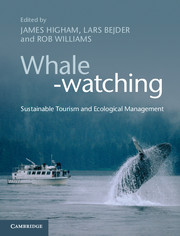Book contents
- Frontmatter
- Dedication
- Contents
- Acknowledgements
- List of contributors
- List of abbreviations
- 1 Tourism, cetaceans and sustainable development
- Part I The historical and contemporary contexts
- Part II Human dimensions of whale-watching
- 7 The whaling versus whale-watching debate
- 8 Iceland and the resumption of whaling
- 9 Green messengers or nature's spectacle
- 10 Whale-watching
- 11 What's in it for the whales?
- 12 Integrating traditional ecological knowledge and community engagement in marine mammal protected areas
- Part III Ecological dimensions of whale-watching
- Part IV Sustainable management: insights and issues
- Index
- Plate Section
- References
7 - The whaling versus whale-watching debate
The resumption of Icelandic whaling
from Part II - Human dimensions of whale-watching
Published online by Cambridge University Press: 05 April 2014
- Frontmatter
- Dedication
- Contents
- Acknowledgements
- List of contributors
- List of abbreviations
- 1 Tourism, cetaceans and sustainable development
- Part I The historical and contemporary contexts
- Part II Human dimensions of whale-watching
- 7 The whaling versus whale-watching debate
- 8 Iceland and the resumption of whaling
- 9 Green messengers or nature's spectacle
- 10 Whale-watching
- 11 What's in it for the whales?
- 12 Integrating traditional ecological knowledge and community engagement in marine mammal protected areas
- Part III Ecological dimensions of whale-watching
- Part IV Sustainable management: insights and issues
- Index
- Plate Section
- References
Summary
Introduction
Iceland is a unique example of a country being a former whaler nation transforming to a whale-watching country, where whale-watching today is a very important industry for the Icelandic economy. The aim of this chapter is to describe in a neutral way the historical aspect of Icelandic whaling history and how the whale-watching industry has evolved during the last 20 years. The whaling history includes old whaling, the time period before modern whaling, which started around 1870 with the Industrial Revolution and the use of a new kind of whaling vessel that increased catch numbers. Iceland is now one of the few places in the world where both whaling and whale-watching of the same species (Minke whales) in the same bay occurs. Of course, this causes many conflicts and a lot of political discussions both nationally and internationally. The changes from an old whaling nation to a whale-watching nation also reflect general changes in society from being a country mainly dependent on the fishing industry to being a country where tourism is a very important industry.
- Type
- Chapter
- Information
- Whale-watchingSustainable Tourism and Ecological Management, pp. 81 - 94Publisher: Cambridge University PressPrint publication year: 2014
References
- 6
- Cited by



